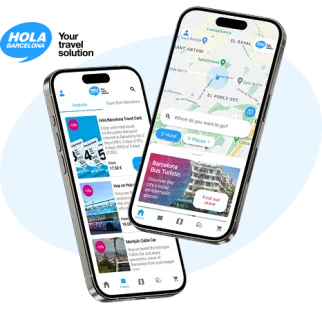Casa Lleó i Morera
Much more than a simple remodelling job
Casa Lleó i Morera, which was built by Lluís Domènech i Montaner on the privileged Passeig de Gràcia, is a neighbour of Casa Amatller, built from 1898 to 1900 by Josep Puig i Cadafalch, and Casa Batlló, built by Antoni Gaudí from 1904 to 1906. These three Modernista buildings jockeyed for top position in that period. However, the only one of the three to win the annual artistic buildings competition held by Barcelona City Council was Casa Lleó i Morera, in 1906.

Barcelona Bus Turístic, on the Hola Barcelona app
Your app for visiting the city with the Barcelona Bus Turístic: routes, stops and the most iconic places. A comfortable way to carry your tickets too!
Why visit Casa Lleó i Morera?
Casa Lleó i Morera is, like Casa Batlló and Casa Amatller, the result of the remodelling of an existing building on Passeig de Gràcia. Its owner, Francesca Morera, commissioned this refurbishment job to Lluís Domènech i Montaner in 1902, but sadly she did not live to see it finished. Her son, Albert Lleó i Morera took over responsibility for the work and gave it the name it is now known by.
During the four years it took to complete the work, Domènech i Montaner comprehensively renovated the building, using a wide variety of materials, and surrounded himself with renowned artists and craftsmen such as the sculptor Eusebi Arnau, the mosaicist Mario Maragliano and the carpenter Gaspar Homar.
Domènech i Montaner broke with the regularity of the distribution and measurements of the original windows, changing their composition on each floor. On the ground floor he made large openings with basket-handle arches, incorporating two female figures by the sculptor Eusebi Arnau, which unfortunately were subsequently destroyed. The pillars upon which the arches rest are decorated with lions and mulberry flowers, the symbols of the owner’s surnames. On the main floor there is a cylindrical bay window with four columns supporting a balcony on the first floor, whose other balconies are rectangular, while on the second floor they are rounded. An outstanding feature is the four female figures on the balconies of the first floor sculpted by Arnau, representing the technological advances of the age: photography, electricity, the phonograph and the telephone. The facade is crowned by a spectacular tempietto, whose construction required a special dispensation to be issued by Barcelona City Council as it pushed the building over the permitted height.
The splendour of Modernisme is inside, reflected in one of the city’s best preserved ensembles: stained glass, mosaics, ceramics, sculpture, wood, marble, sgraffito… The house is no longer open to the public, but much of its original furniture is exhibited at the National Art Museum of Catalonia. It includes some of the best examples of Gaspar Homar designs, decorated with wood carvings, marquetry and even inset stained glass. It is a clear example of close collaboration between the architect Domènech i Montaner and his carpenter.
How do you get to Casa Lleó i Morera?
To get to Casa Lleó i Morera hop off at the Casa Batlló – Fundació Antoni Tàpies stop on the Red and Blue Routes of Barcelona Bus Turístic.
For the most curious of you
- Did you know? Pau Audouard, the official photographer of the 1888 Barcelona Universal Exposition, installed his studio in Casa Lleó i Morera. He was one of Barcelona’s leading photographers at the turn of the century and one of his portraits that has survived to this day is of Gaudí shortly after completing his architecture studies.
- Local’s tip: Given that Casa Lleó i Morera is now not open to the public, a virtual tour is highly recommended.
- A must: To complete the route of the ‘Illa de la Discòrdia’ or Block of Discord, so called due to the contrasting styles evident in its three Modernista buildings designed by Barcelona’s three most important architects of the Modernisme movement: Casa Batlló by Gaudí, Casa Amatller by Puig i Cadafalch, and Casa Lleó i Morera by Domènech i Montaner.











